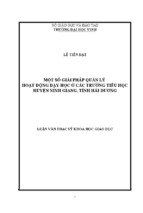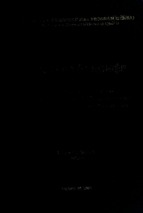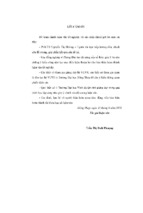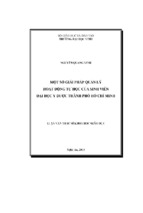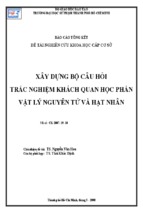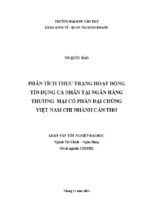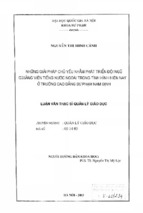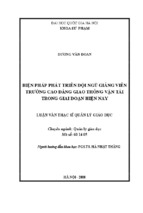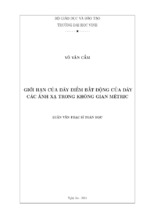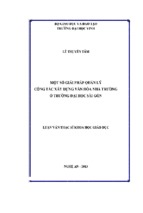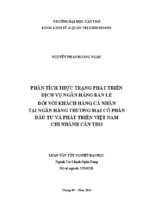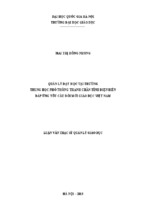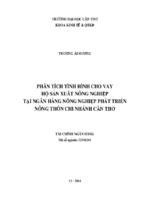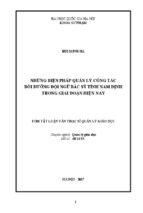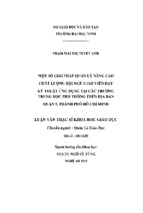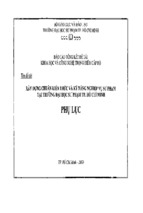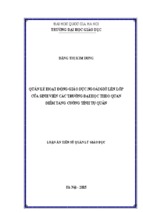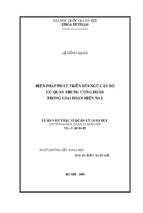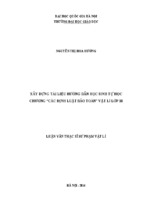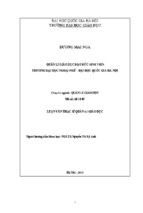VIETNAM NATIONAL UNIVERSITY, HANOI
UNIVERSITY OF LANGUAGES AND INTERNATIONAL STUDIES
FACULTY OF POST-GRADUATE STUDIES
NGÔ THANH HUYỀN
A STUDY ON IRONY RELATED TO FEMALE
CHARACTERS IN SOME SHORT STORIES BY
W.S. MAUGHAM
(Nghiên cứu về phép châm biếm liên quan đến nhân vật nữ trong một số
truyện ngắn của W.S.Maugham)
M.A. MINOR PROGRAMME THESIS
Field: English Linguistics
Code: 60220201
Hanoi - 2016
VIETNAM NATIONAL UNIVERSITY, HANOI
UNIVERSITY OF LANGUAGES AND INTERNATIONAL STUDIES
FACULTY OF POST-GRADUATE STUDIES
NGÔ THANH HUYỀN
A STUDY ON IRONY RELATED TO FEMALE
CHARACTERS IN SOME SHORT STORIES BY
W.S. MAUGHAM
(Nghiên cứu về phép châm biếm liên quan đến nhân vật nữ trong một số
truyện ngắn của W.S.Maugham)
M.A. MINOR PROGRAMME THESIS
Field: English Linguistics
Code: 60220201
Supervisor: Dương Thị Nụ, PhD.
Hanoi - 2016
TABLE OF CONTENTS
DECLARATION .................................................................................................. i
ACKNOWLEDGEMENT ................................................................................... ii
ABSTRACT .......................................................................................................... iii
TABLE OF CONTENTS ..................................................................................... iv
LIST OF TABLES AND FIGURES ................................................................... v
PART I: INTRODUCTION ................................................................................ 1
1. Rationale ............................................................................................................ 1
2. Aims of the study ............................................................................................... 2
3. Scope of the study .............................................................................................. 3
4. Significance of the study .................................................................................... 3
5. Design of the study............................................................................................. 3
PART II: DEVELOPMENT ............................................................................... 5
CHAPTER 1: REVIEW OF THEORIES AND RELATED LITERATURE 5
1.1. Theoretical Background .................................................................................. 5
a. Characterization .................................................................................................. 5
b. An overview of irony ......................................................................................... 6
c. Irony in Pragmatics ............................................................................................ 9
1.2. Related Literature ............................................................................................ 14
a. W.S.Maugham’s life and career ......................................................................... 14
b. Previous studies on irony ................................................................................... 16
CHAPTER 2: METHODOLOGY ...................................................................... 19
2.1. Research design ............................................................................................... 19
I
2.2. Data and data source ....................................................................................... 20
2.3. Data collection procedure ............................................................................... 20
2.4. Data analysis procedure .................................................................................. 20
CHAPTER 3: DATA COLLECTION AND ANALYSIS ................................ 22
3.1. Data Collection................................................................................................ 22
3.2. Data Analysis .................................................................................................. 22
a. “The Three Fat Women of Antibes” .................................................................. 22
b. “The Escape” ...................................................................................................... 24
c. “The Luncheon” ................................................................................................. 26
d. “Louise” ............................................................................................................. 28
e. “Winter Cruise” .................................................................................................. 30
CHAPTER 4: FINDINGS AND DISCUSSION ................................................ 33
4.1. Types of irony used in the development of the female characters ................. 33
4.2. Pragmatic functions of these ironic expressions ............................................. 34
4.3. W.S. Maugham’s use of irony in the selected short stories ............................ 36
PART III: CONCLUSION .................................................................................. 38
1. Recapitulation .................................................................................................... 38
2. Limitations of the study ..................................................................................... 38
3. Implications for language teaching and learning ............................................... 39
4. Suggestions for further study ............................................................................. 39
REFERENCES .................................................................................................... 40
APPENDIX………………………………………………………………………..I
II
PART 1: INTRODUCTION
1. Rationale
The
term
“irony”
is
derived
from
the
ancient
Greek
word
εἰρωνεία (eirōneía), which means dissimulation. As a rhetorical device, irony refers
to the disagreement between the meaning intended by the author and what is
actually said.
It is believed that irony plays an important role in literature as one of the
most effective rhetorical devices. In some cases, it is even more efficient than a
direct statement since it helps create a private joke between the author and the
readers. Besides, irony is also intended to provoke the readers into critical thinking
and analyzing a situation. By comparing and contrasting what appears to be the
case, and what is actually the case, the readers can arrive at a better understanding
of the author’s intent. For example, in “Lemony Snicket: The Unauthorized
Autobiography”, Snicket writes:
“Today was a very cold and bitter day, as cold and bitter as a cup of hot
chocolate; if the cup of hot chocolate had vinegar added to it and was placed
in a refrigerator for several hours.”
As can be seen from the above sentence, Snicket makes an enjoyable ironic
statement by creating a structure that is more complex than what a reader may
usually expect.
In terms of pragmatics, irony can also be considered a subject of interest
which has been studied by many linguists such as Grice (1975), Amante (1981),
Kaufer (1981), Muecke (1982), Brown and Levinson (1987), and Hutcheon (1992).
However, irony has still remained its attraction as well as complexity as Balconi
and Amenta (2008, p.9) stated:
III
“Although frequent in our everyday conversations, irony remains a complex
communicative and pragmatic phenomenon whose correct decoding requires
specific linguistic, communicative and cognitive abilities.”
Since how irony works, positively or negatively, depends on several factors
such as people’s taste, points of view, habits, education, it seems to be really
difficult to fully understand irony in daily communication and especially literary
works.
Being inspired by the complexity of irony in literary works, the writer of this
thesis would like to investigate how ironic expressions are employed in some fiction
writings. When she approached British Literature, she was strongly impressed by
W.S. Maugham. Maugham is a famous English writer whose writings are
characterized by narrative facility, simplicity of style and an ironic point of view.
After reading a collection of Maugham’s short stories, the writer was fascinated by
the way Maugham portrayed his characters, especially female characters. They were
described not only specifically but also vividly.
All of these inspire the study: “A Study On Irony Related To Female
Characters In Some Short Stories By W.S. Maugham”
2. Aims of the study
The main aims of the research are as follows:
-
To identify different ironic expressions used in the development of female
characters in some short stories by W.S. Maugham
-
To realize the role and contribution of these ironic expressions to the
development of female characters in the selected stories.
-
To propose an insight into Maugham’s use of irony
IV
In order to achieve the above aims, the study is conducted to find out the answer
to the following research questions:
1. What are the ironic expressions used in the development of female
characters in some short stories by W.S. Maugham?
2. What are the pragmatic functions of these ironic expressions?
3. What are the features of Maugham’s use of irony displayed through the
selected short stories?
3. Scope of the study
This study focuses on the ironic expressions in only some short stories
written by W.S. Maugham. The main emphasis of the study is put on identifying
these ironic expressions and their pragmatic functions to propose an insight into
Maugham’s use of irony.
4. Significance of the study
Theoretical significance: This study is expected to verifying the correctness
and significance related to pragmatictic theories of irony by working on some
fiction works
Practical significance: This thesis helps gaining an insight into the use of
ironic expressions in some short stories by W.S. Maugham.
5. Design of the study
The study consists of three main parts:
Part 1: Introduction
In this part, the writer would like to present the rationale, the aims of the study, the
research questions, the significance and the scope of the study as well as the
research methodology.
V
Part 2: Development
This is the most important part of the study which consists of the following
contents: Review of theory and related literature, Data collection and analysis, and
Findings and discussion.
Part 3: Conclusion
In the final part, the writer will briefly present the summary of the study, the
limitations, the implications in language teaching and learning as well as some
suggestions for further study.
VI
PART II: DEVELOPMENT
CHAPTER 1: REVIEW OF THEORY AND RELATED LITERATURE
In this chapter, the writer presents the theoretical background related to
characterization, irony and irony in pragmatics. Basic information about W.S.
Maugham as well as previous studies on irony is also briefly reviewed.
1.1. Theoretical Background
a. Characterization
According to Harrison (1998, p.51), characterization is the concept of
creating characters for a narrative.
Writers build characters by revealing their appearance, speech, thoughts,
actions and other characters’ reactions.
Regarding appearance, writers portray characters by describing their looks,
clothes, and demeanor. For example, in “A Christmas Carol”, Charles Dickens
described Scrooge with the following lines:
“The cold within him froze his old features, nipped his pointed nose,
shriveled his cheek, stiffened his gait; made his eyes red, his thin lips blue…”
Apart from appearance, characters can be created through speech. If a story
is told by a first-person narrator, he reveals his personal trait as he tells his own
story as well as what he thinks or feels by using pronouns like I, me or we.
However, there are some cases in which some first-person narrators mislead or lie
to the audience. Besides, dialogue also reveal a lot about characters and their
relationships with each other. Therefore, when analyzing the characterization in a
story, readers should pay attention to what characters say and do not say and how
they respond to each other.
VII
Concerning actions, what characters do and how they treat each other often
reveal the most about them. By observing characters’ actions, readers are able to
determine what characters’ personality is, what motivates them and how they deal
with conflict.
Additionally, writers can take readers into the characters’ minds to describe
their thoughts and feelings. As reading, readers are able to investigate whether the
characters’ thoughts and feelings match their speech and actions.
Last but not least, writers also build a character by describing how other characters
react to him/her.
In terms of types, there are two types of characterization: direct and indirect.
While direct characterization tells readers directly what characters are like or what
their motives are, indirect characterization shows readers the characters through
speech, appearance, thoughts, actions and other characters’ reactions but allow
readers to decide what characters are like.
b. An over view of irony
Definition of Irony
Until now, it seems that there is no persistent definition for the term “irony”
since it depends on the study field in which irony is researched.
The term “irony” has its root in Greek and derives from εἰρωνεία (eirōneía),
which means dissimulation. Nowadays, irony is widely used to refer to a
contradiction between appearance / expectation and reality. As a figure of speech,
irony refers to the disagreement between the meaning intended by the author and
what is actually said.
According to Thompson (1948, p.10), irony can be understood as
VIII
“a discrepancy or incongruity between expression and meaning, appearance
and reality, expectation and event. What we notice and then call irony is a
striking discrepancy which is artfully arranged to draw attention to itself, or
which, through occurring by chance, likewise compels our attention.”
Specifically, Muecke (1969, p. 53) defined irony as
“ways of speaking, writing, acting, behaving, painting, etc., in which the real
or intended meaning presented or evoked intentionally quite other than, and
incompatible with, the ostensible or pretended meaning.”
Besides, briefly, Galperin (1971, p.142) claimed that irony was a rhetorical
device which based on recognition of the logic – dictionary meaning and contextual
meaning while these two coexisting meanings were opposite.
From these views, it can be concluded that irony means far more than just
“saying one thing meaning another”. The term is used to refer to the way of using
words to express something different from and often opposite to their literal
meaning. In short, an expression or utterance is considered as an ironic one when it
is characterized by a contrast between apparent and intended meanings.
Types of irony
There are two classifications of irony; while the first one is based on what
the ironist expects from his semantic displacement, the second one takes modern
theories of rhetoric as its basis.
- Classification based on semantic displacement
First and foremost, irony can be classified on the basis of what the ironist
expects from his semantic displacement. These are classic irony, romantic irony,
and critical irony. (Erdogan, 2010)
IX
REFERENCES
1. Austin, J.L. (1962). “How to Do Things with Words”. Oxford: The
Clarendon Press.
2. Bacolni, M. & Amenta, S. (2008). “Isn’t it Ironic? An Analysis on the
Elaboration of Ironic Sentences with ERPs”. The Open Applied Linguistics
Journal. 1. p. 9-17.
3. Barbe, K. (1995). “Irony In Context”. Philadelphia: John Benjamins
Publishing Company.
4. Colebrook, C. (2004). “Irony”. London: Routledge
5. Cook, Jiyon. (2005). “A Pragmatic Analysis of Irony”. Language &
Information Society, 6, p. 18-35.
6. Cuddon, J.A. (1998). “A Dictionary of Literary Terms and Literary Theory”.
4th Ed. Oxford: Blackwell Publishers.
7. Erdogan, A. (2010). “On The Concept of Irony in Rorty”. Unpublished MA
Thesis – The Graduate School of Social Sciences – Middle East Technical
University.
8. Galperin, I.R. (1971). “Stylistics”. Moscow : Higher School Publishing
House.
9. Giora, R. (1998). “Irony”. In J. Verschueren, J-O. Östman, J. Blommaert and
C. Bulcaen (eds.). “Handbook of Pragmatics” (1-21). Philadelphia: John
Benjamins.
10. Grice, P. (1975). “Logic and conversation”. Syntax and semantics 3: Speech
arts.
Cole
et
al.
p.41-58.
Elsevier.
Retrieved
from
http://www.ucl.ac.uk/ls/studypacks/Grice-Logic.pdf
11. Harrison, M. (1998). “The Language of Theatre”. London: Routledge. ISBN
0-87830-087-2, p.51-52.
12. Hirsch, G. (2011). “Between Irony and Humour: A Pragmatic Model”.
Pragmatics & Cognition, 4, p. 530-561.
X
13. Huang, Lihua, (2011). “A Pragmatic Study of Irony in Samuel Beckett’s
Plays”. Applied Economics, Business and Development: International
Symposium 2011, p.22-27.
14. Lang, B. (1996), “The Limits of Irony”. New Literary History, 27 (3), p. 571588.
15. Leech,G.N. & Short, M.H. (2001). “Style in Fiction: A Linguistic
Introduction to English Fictional Prose”. Beijing: Foreign Language
Teaching and Research Press.
16. Maugham, W.S. (1988). “Sixty-five Short Stories”. London: William Clowes
Ltd.
17. Muecke, D.C. (1969). “The Compass of Irony”. London: Methuen & Co Ltd.
18. Ospina, S. (2004). “Qualitative Research”. US: New York University Press
19. Palinkas, I. (2013). “Irony and The Standard Pragmatic Model”.
International Journal of English Linguistics, 3(5), p.14-19.
20. Patton, M.Q. (2002) “A Guide To Using Qualitative Research Methodology”.
Retrieved May 15th, 2015 from
http://evaluation.msf.at/fileadmin/evaluation/files/documents/resources_MSF
/MSF_Qualitative_Methods.pdf
21. Searle, J. (1969). “Speech Act. An Essay in the Philosophy of Language”.
UK: Cambridge University Press.
22. Snicket, L. (2002). “Lemony Snicket: The Unauthorized Autobiography”.
US: Harper Collins.
23. Sperber, D., & Wilson, D. (1995). “Relevance: communication & cognition”.
Cornwall: T. J. Press Ltd.
24. Thompson, A.R. (1948). “The Dry Mock: A Study of Irony in Drama”. US:
University of California Press.
25. Van Dijk, T.A. (ed.). (1976). “Pragmatics of Language and Literature”.
Holland: North-Holland Publishing Company.
XI
26. Zhang, Ting (2013). “Irony in The Mayor of Casterbridge: A Literary
Pragmatic Study”. International Journal of Knowledge and Language
Processing, 4(1), p. 35-46.
XII
- Xem thêm -

